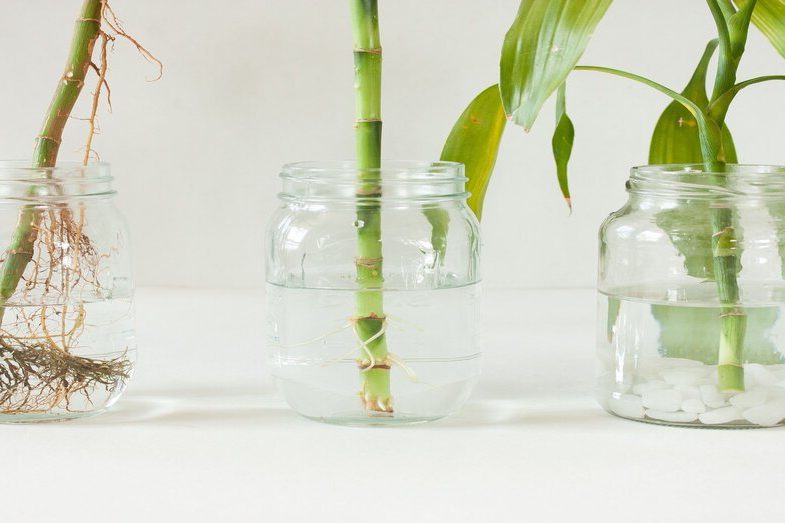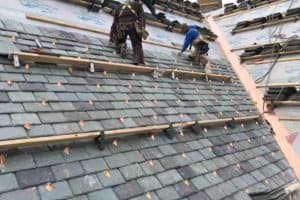How long does it take for bamboo to grow? It is important to understand the growth rate of bamboo before you plant it. It is also useful to know how to control its growth. In this article, I will describe exactly how long it takes for bamboo to grow, as well as growth management tips.
How long for bamboo to grow? It takes bamboo about 3 years to develop its roots and establish itself in the ground. It takes 5 to 7 years for the bamboo to reach maturity and be ready for harvest.
Once bamboo is deeply rooted, after about 3 years, new shoots will emerge in the spring. These shoots will continue to grow for the next 60 days. Then they will get bigger and multiply in numbers every year as the colony grows into its maturity.
Bamboo can yield up to 20 times more than any softwood or hardwood tree. Before an average tree can reach five years into its maturity, you have already harvested 200 poles of bamboo during that period.
You can propagate bamboo using three methods, namely vegetative propagation, tissue culture, and planting seeds.
Read on to learn more about how long it takes for bamboo to grow and how to control its growth.
How Long Does It Take for Bamboo to Grow?
When bamboo has established itself on the ground, it will take seven years for the colony to mature and be ready to harvest. Bamboo has a greater yield than any softwood or hardwood tree. This tree can yield 20 times more than the yield of other trees.
Botanically speaking, bamboo is a grass, not a tree. But since it is commonly referred to as a tree, I will use ‘tree’ to refer to bamboo in this article.
Bamboo can establish itself on the ground in three years. Shoots will sprout around the original plant and grow for the next two months. In the fifth year, it will start to grow at an amazing speed.
For instance, a species of Chinese bamboo tree can reach a height of 90 feet in just five weeks. It’s almost like you are seeing it grow right before your very eyes. Thus, you will be able to harvest your bamboo trees in just 7 years. Compare that to the average tree, which you can only harvest when it has reached its maturity 10 or maybe even 15 years after.
If your bamboo trees are planted in sun-prone areas, they can get more food. The more food they produce, the faster they will grow. Most bamboo trees are sun-loving plants, so that they will thrive in sunlit areas. But there are also some bamboo species that prefer filtered sunlight.
How Does Bamboo Normally Grow?
Typically, bamboo trees grow from the root mats of already established plants. While they can be grown from seeds, this is somewhat difficult, so it is very rare. Once established, the bamboo shoots grow fast. In fact, you can see their visible growth from day to day – given the right conditions.
They are so fast-growing that in some places, bamboo trees are considered invasive. Bamboo is one of the toughest plants to get rid of once it has established itself. So, you have to really think about your decision to grow bamboo trees in your place, wherever you want to plant them.

How Do You Propagate Bamboo?
There are many proven ways to propagate bamboo. Choose the best that will apply to your situation and your requirement.
Method 1: Vegetative Propagation
This method involves the planting of potted bamboo saplings that are about 1 to 2 feet high. Vegetative propagation is one of the easiest ways to plant bamboo trees since the saplings already have potting soil to start them off for healthy growth.
When you use this method, it will take the bamboo trees from six months to two years to reach a height of two meters. The rate of growth of the trees will depend on the soil they are planted on, the temperature in the area, and how they are watered.
Method 2: Tissue Culture
In this method, agriculture technicians grow bamboo saplings inside a laboratory under a controlled environment. After the saplings have reached a certain age and height, they are transferred to another place where they will be hardened for a certain period.
When the saplings are already hardened, they will be transplanted on farms. By this method, and with the right irrigation strategy, you can expect bamboo trees to reach heights of 2 meters in just 6 to 8 months.
Method 3: Planting Seeds
The success of this method depends upon the age of the seeds and their availability. Fresh seeds will have the highest rates of germination. The quality of the seeds will also affect their germination rate. If the seeds are fresh and are of high quality, their chances of germination will be very high.
If this method is used, it will take from 6 months to 2 years before the bamboo trees can reach the height of 2 meters. Their growth will also depend on the soil, temperature, and water availability.
How Long for Bamboo to Grow – Video
The above video is great at demonstrating how bamboo trees develop from a bamboo rhizome. From the video, you will see that in about 20 days, there are already three little shoots coming out of the rhizomes. One week later, the three little shoots became bigger. Brand new shoot sprouts as well.
Another week later, the three original shoots are much bigger and are starting to branch out. Nearly two months later, many shoots have already established themselves. They need a new container. One whole year later, the sprouts have grown taller and have developed into what you can call bamboo trees.
Factors That Determine How Long It Takes for Bamboo to Grow
The growth rate of bamboo also depends on many factors. You need to consider these factors if you want to propagate or control bamboo tree growth. What are these factors?
1. Climate and Weather
Tropical climates with warm temperatures are the best places to grow most of the species of bamboo. But there are hardy varieties that can also grow in colder climates. Those which grow in colder climates are the running types. These varieties spread fasts and are considered very invasive. The clumping varieties spread slowly.
2. Soil Conditions
Bamboo is not very particular with regard to soil conditions. You can grow these trees in most soil types. The reason for this is that bamboo has very shallow roots. For the bigger varieties, it is around 50 centimeters, and for the smaller varieties, it is approximately 30 cm.
3. Water Conditions
Bamboo trees prefer lots of water combined with well-drained soils. But you can restrict the supply of water for clumping varieties if you want to contain them in one particular area. Running types need so much water.
4. Availability of Sunlight
According to the American Bamboo Society, most large bamboo species thrive in full sun. But there are varieties like Thammocalamus and Fargesias that like to grow under the shade, especially during the hottest hour of the day.
5. Fertilization
Bamboo will grow better and faster if given fertilizer or plant food that is high in nitrogen. A fertilizer with 20-5-5 or 20% total nitrogen, 5% available Phosphoric Acid (P2O5), and 5% soluble potash (K2O) is a good example. A good alternative to chemical fertilizer is lawn fertilizer. The best option is organic fertilizer.

We’ve answered the question, “How long does it take for bamboo to grow?”; next, let’s look at tips on making it grow faster.
Tips for Making Bamboo Grow Faster
Bamboo can take quite a while to establish itself and grow. As mentioned earlier, it can take about 3 years for the bamboo roots to grow and establish themselves in the ground.
If you want to grow bamboo faster, here are the tips that you should follow:
1. Plant Bamboo in Places Where There’s Lots of Sunlight
Most species of bamboo trees thrive best in sunlit areas. Sunlight is their food, so the more food you give them, the faster they will grow. Some species prefer filtered light, but the majority of bamboo species are sunlight lovers.
2. Give It Plenty of Water
Bamboo needs an abundant supply of water because it is always thirsty. While young plants are establishing themselves on the ground, they need lots of water. But once settled, they do not need much. On average, water them every one to three days.
Give them more water during summer and on windy days. The best method of watering bamboo is to saturate the ground around the base of the trees. Keep on watering the soil until you notice that it no longer absorbs the liquid.
3. Fertilize It
The best fertilizer to use for bamboo is organic fertilizer. This type of fertilizer aid in bamboo’s faster growth. And the best time to give your plants this food is during spring and summer. That’s when they are growing up.
Potassium, nitrogen, and silica are some of the best nutrients for your bamboo trees. But don’t give them salt because this will inhibit their growth. Organic fertilizers are also the best since you will not harm the soil with synthetic chemicals.
4. Plant It in Soil with the Right Conditions
While bamboo is not picky with the quality of the soil, it can best grow if you choose to plant them in soil with better conditions. You can achieve optimal bamboo growth with ground that has pH 7, neutral soil. It would be better if the soil was well-aerated, sandy loam, high in organic matter, and had good drainage.
5. Mulch It Regularly
Whenever you water bamboo trees, mulch them as well. The idea is to prevent water from evaporating. So, the best way to do this is to mulch the plant around its base. Provide your bamboo a thick layer of mulch. Mulching will keep the soil around the stem of the bamboo moist and will allow its horizontal roots to grow.
For mulching medium, you can use leaf litter, sawdust, wood barks, manure, chipped wood, or compost. A mulch height of about 15 centimeters will give maximum results. This mulch will break down slowly and provide additional nutrients to the bamboo.
6. Prune Whenever It Is Needed
Pruning dead parts of the bamboo will also help it grow faster. When you remove the dead culms or the woody ring stems, the living culms will get more sunlight, thus encouraging the faster growth of the whole tree.
7. Plant It Correctly
The right way of planting bamboo saplings is to dig one and a half times the height of their pots or their soil mediums and twice as wide. Place the saplings into the hole. Put some aerated organic matter around the root. This method will induce faster growth since the roots will have less resistance as they grow. Finally, fill up the hole with compost or good-quality soil.
Tips for Controlling or Stopping the Growth of Bamboo
There are three natural methods by which you can slow down, control, and even stop the growth of bamboo trees. They are the following:
1. Prune the Roots
The underground roots of bamboo are called rhizomes. If you don’t want the bamboo to spread, cut these roots. This way, they will not crawl. If these rhizomes can’t establish themselves, they won’t be able to produce cranes.
2. Destroy the New Shoots
New shoots will appear every year in spring. The best time to remove them is after they have reached around 6 to 12 inches tall. At this time, their water contents are very high. This will support their rapid growth for their first 60 days. It is time that they are very fragile. So if you destroy them at this time, you will be able to control the growth of your bamboo trees.
3. Establish Root Barriers
Placing root barriers around the bamboo tree will prevent its roots from spreading where you don’t want them to go. This method is ideal for bamboo of the running variety. These barriers will contain them in a specific area that you want them to stay.
Conclusion: How Long Does It Take Bamboo to Grow?
So, to recap, how long does it take for bamboo to grow? It takes bamboo about 3 years to develop its roots and establish itself in the ground. It takes 5 to 7 years for the bamboo to reach maturity and be ready for harvest.
Bamboo trees can yield up to 20 times more than any wood. Before an average tree can reach five years into its maturity, you have already harvested 200 poles of bamboo during that period.
You can propagate bamboo using three methods: tissue culture, vegetative propagation, and planting seeds.
With this knowledge, I hope you have a greater understanding and a greater degree of patience for growing bamboo.
Read next:

![How Long Does DayQuil Last? [How Long It Stays in Your System] how long does dayquil last](https://howchimp.com/wp-content/uploads/2021/06/how-long-does-dayquil-last-300x200.jpg)
![How Long Does DHL Take to Deliver? [DHL Delivery Time] How Long Does DHL Take to Deliver](https://howchimp.com/wp-content/uploads/2021/05/how-long-does-DHL-take-to-deliver-300x200.jpg)


